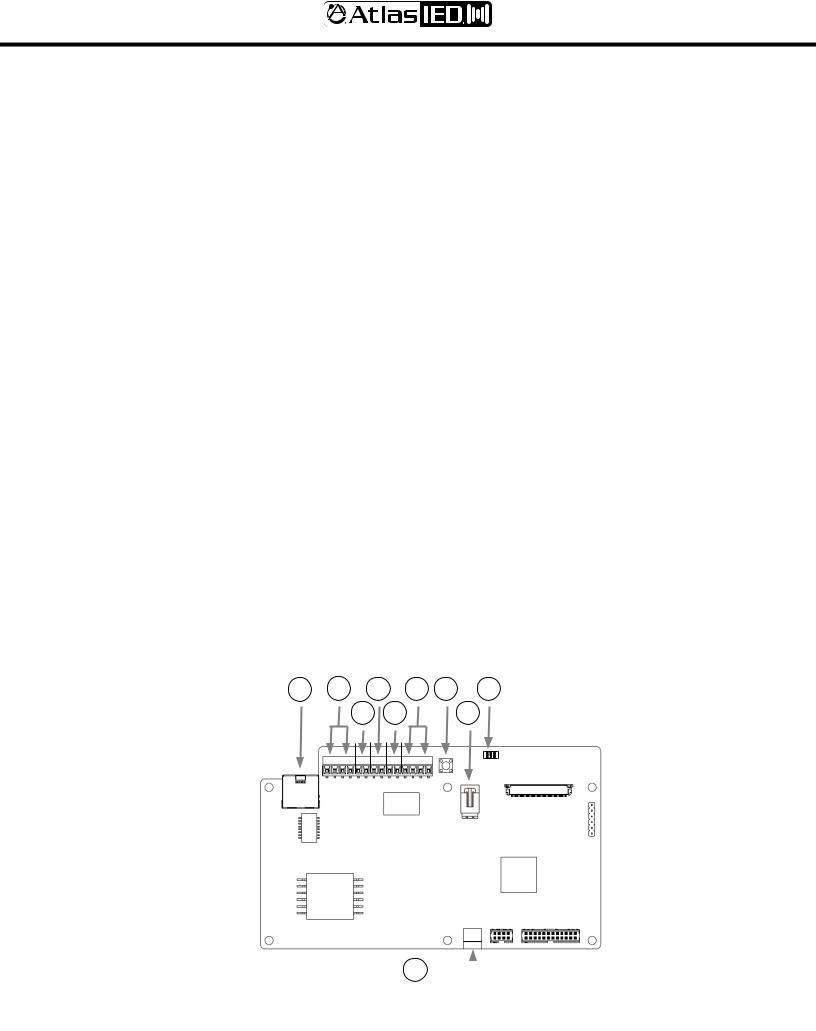Atlas IED IP-12SYSM, IP-HVP Installation Manual

RegisteredTrademark of Innovative Electronic Designs LLC. All rights reserved. |
development, specifications are subject to change without notice. ATS005822 RevB 2/19 P/N 492198 |
IED is a |
product |
Atlas Sound L.P. |
Due to continual |
Sound are trademarks of |
endorsement is implied. |
©2019 Atlas Sound LP. The Atlas “Circle A”, Soundolier, and Atlas |
All other Trademarks are property of their respective owners. No |
IP Endpoint Speakers
Install Sheet
Introduction
AtlasIED IP endpoint speakers consist of a factory assembled speaker and baffle with PCB amplifier / control board securely mounted to the rear of the baffle. The amplifier / control board is capable of producing 15-watts RMS into the 8Ω speaker with IEEE 802.3at compliant PoE switches. A local 24VDC PSU (TSD-PS24V2500MA) may also be used instead of PoE switches. Interconnection is via a board mounted female RJ-45 connector. All models are compatible with AtlasIED’s GLOBALCOM, GLOBALCOM.IP, GCK, Syn-Apps Revolution, Singlewire’s InformaCast software, and SIP
standalone operation. They also include 2 general purpose inputs, 1 relay output, 1 line out, and 1 line input, and two-way microphone. Note: Speaker may take up to 1 min to boot up on initial start up.
Models may include the following:
•8" Speaker
•6" Horn Speaker
•Liquid Crystal Display (LCD)
•Flasher
•Microphone
Functionality
Before installing, note the unit’s MAC address found on the units main circuit board (example 00:02:C1:81:00:00). Once connected to a network and powered, the IP endpoing speaker will boot up and automatically obtain an IP address from a DHCP server on the network. Next, the unit will start the registration process to find the controller software. Once the IP speaker identifies the software’s location, it will send a registration request to the software and register. The MAC address of the unit will then show in the software. Please refer to the installation manual of the software for additional configuration settings.
After the module has registered with the software, its HTTP page can be accessed by navigating to its IP address with any Internet browser. This page will show its current firmware version and registration information. If unsure about the IP address, press the unit’s service button for 1 second. The unit’s IP address will be announced over the speaker.
A.Power Input (WARNING: Do not use in conjunction with PoE)
B.General Purpose Inputs 1 and 2
C.Relay Output
D.Line Level In
E.Line Level Out
F.Loudpeaker Outputs - The primary output is connected to the baffle speaker (or horn). The secondary output may be used to drive another 8Ω speaker or horn.
G. Network Input |
G |
F |
D |
|
|
|
B |
H |
I |
|||
H. |
Service Switch |
|
|
|
||||||||
|
E |
|
|
C |
|
|
|
|
J |
|||
I. |
Force Discovery Jumpers (A,B,C) |
|
|
|
|
|
|
|
||||
|
|
|
|
|
|
|
|
|
|
|
||
J. |
2-Way Mic Input |
|
|
|
|
|
|
|
|
|
|
|
|
|
|
14 13121110 9 |
8 |
7 |
6 |
5 |
4 |
3 |
2 |
1 |
|
A 
1601 JACK MCKAY BLVD. |
TELEPHONE: (800) 876-3333 |
AtlasIED.com |
|
ENNIS, TEXAS 75119 U.S.A. |
SUPPORT@ATLASIED.COM |
||
|
|||
|
|
|

RegisteredTrademark of Innovative Electronic Designs LLC. All rights reserved. |
development, specifications are subject to change without notice. ATS005822 RevB 2/19 P/N 492198 |
IED is a |
product |
Atlas Sound L.P. |
Due to continual |
Sound are trademarks of |
endorsement is implied. |
©2019 Atlas Sound LP. The Atlas “Circle A”, Soundolier, and Atlas |
All other Trademarks are property of their respective owners. No |
GPI Interface
General purpose inputs (GPI’s) are used to trigger events in the Control software packages. Refer to software manuals for functionality. Relay Output is Controlled via software packages. Refer to software manuals for functionality.
Mounting
Each model has a specific mounting enclosure that can be Flush Mount, Surface Mount Straight, or Angled Surface Mount. Models include: Flush Mount Enclosures: IP-FEC-DM, IP-FEST-HVP, IP-FEST-S, IP-FEST-SD
Surface Mount Enclosures: IP-SEST-HVP, IP-SEST-S, IP-SEST-SD, IP-SEST-SNK, IP-SEC-DM Surface Mount Angled Enclosures: IP-SEA-S, IP-SEA-SD
Note: The IP-12SYSM(F) and IP-22SYSM(F) models are sold with an integrated enclosure for drop ceilings.
IP Speaker Connector Block Pin Configuration
A 14 pin screw type connector block (J2) will be used to allow connections to the controller.
Pin Description |
|
|
|
||
1 |
GPI In 2 + |
8 |
Line-In -- |
|
|
2 |
GPI In 2 |
GND |
9 |
Line-Out + |
|
3 |
GPI In 1 |
+ |
10 |
Line-Out -- |
|
4 |
GPI In 1 |
GND |
11 |
Speaker 1 Out + |
|
5 |
Relay |
|
12 |
Speaker 1 |
Out -- |
6 |
Relay COM |
13 |
Speaker 2 |
Out + |
|
7 |
Line-In + |
14 |
Speaker 2 |
Out -- |
|
Note: Pin 14 is located next to the RJ45 jack. Misc Settings
1.Service Button - The only push switch located on the main circuit board.
•Press 1 sec - The current IP address will be spoken (in English) through the 8Ω speaker
•Press 10 sec - Factory reset
•Press and hold while applying power. Hold the button until the Status LED on the circuit board starts blinking rapidly to perform a factory reset without any servers present
2.Force Discovery - In some cases, auto discovery may not work correctly. In these cases, the A, B, and C jumper located under the service button may be enabled.
•Jumper A - Singlewire
•Jumper B - Syn-Apps
•Jumper C - GCK
Grille Removal
Each IPX endpoint speaker ships with an included grille removal tool. This tool is designed to make removal of the grille easy, reducing the chance of damage. Using the hooked end of the removal tool, insert into one of the holes at the edge of the grille. Gently apply pressure away from the speaker assembly to remove the grille. Once one side is out of the baffle, the integrator can use thier hands to pry the rest of the grille out.
Speaker Switch (Available only on models ending in -72)
This switch enables an installer to replace an existing 25V/70V speaker in a room with a new IPX speaker during a retro fit project while retaining the use of the existing analog paging/intercom system. Once the analog system is taken off-line and the new IP system is brought on-line, the baffle mount switch can be changed from 25V/70V mode to IP mode.
Installation for Retrofit Applications:
Remove the old 25V/70V speaker, connect the existing speaker line to the transformer mounted to the IPX speaker noting tap settings (see chart below). Connect the newly installed network cable to the RJ-45 connector on the IPX controller board. Install the IPX speaker in the new installed enclosure and set the switch to 25V/70V mode. Once the IP system is set-up and running, change the switch to IP mode.
1601 JACK MCKAY BLVD. |
TELEPHONE: (800) 876-3333 |
AtlasIED.com |
|
ENNIS, TEXAS 75119 U.S.A. |
SUPPORT@ATLASIED.COM |
||
|
|||
|
|
|
